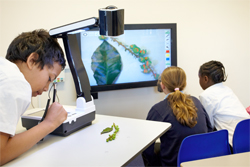As a commentator recently said on Radio 4, “never let a good crisis go to waste!” With change being the only constant in education, I took the relative peace of a moonlit dog walk in Sheffield’s beautiful Meersbrook Park (which featured in X+Y and Four Lions!) to contemplate the challenges and opportunities available to Science teachers and leaders over the coming years.
Around 400 secondary school pupils from South Wales will attend a one-off summer school lead by NASA astronaut Steve Swanson. The Mission Discovery programme will celebrate the sciences, and the renowned engineer will team up with Bishop Hedley RC High School in Merthyr Tydfil to let pupils spacewalk in an astronaut's shoes, according to Wales Online.
Pupils at Gaskell Primary in Bolton last week enjoyed five days of scientific adventures. In order to get in on the National Science Week action, the school’s teachers organised a series of events and workshops for the children, according to The Bolton News.
Space, the final frontier. These are the voyages of... well pupils from my school, I hope! Our pupils and perhaps ‘our own personal children’, as I call my sons, could possibly be travelling up to space in their latter years. It’s something that is becoming agility, core strength, stamina and dexterity. The mission activities are planned weekly at school and work well with year 5 pupils, as it is part of their science curriculum and the PE element forms part of their requirements for the term.
With a plethora of edtech available to schools, it’s a great time to be studying Science. However, much of this learning risks being wasted if kids can’t apply it to real life, everyday examples. BPES are offering a variety of free resources to tackle this.

The BP Educational Service (BPES) is taking science out of the lab and into the real world with ‘Where's the Science in that?’, a set of new free resources for students aged 9 to 14. These resources have been designed to fit closely with the new National Curriculum for England. They also support the curricula for Scotland, Wales and Northern Ireland. The focus is on inspiring young people to see science in a new light. The interactive teaching resources are compatible with whiteboards, PCs, iPad and Android tablets.
According to a recent BBC news article, business leaders have said a growing shortage of skills in the hi-tech sector is threatening Britain's economic recovery. Graduates in science, technology, engineering and maths (STEM) are vital in order to tackle the current skills shortage in the UK and ensure the future prosperity of our country. Interestingly, however, the findings of a survey by YouGov revealed that the majority of children enjoy science as a subject. This should be encouraged from primary level, and schools need to continue to make science appealing to students as they progress through compulsory education, to encourage a higher level of interest in science-related careers.
A lot of pupils are going to be enthused by STEM (science, technology, engineering and mathematics) subjects, and plenty of teachers like to run clubs around them. STEMNET’s Lisa Thompson gives her top tips on how to get a great STEM club running.

Many teachers would love to run an after school club with a handful of enthusiastic students where they get to explore all the fun things they just don’t have time for in the curriculum. The problem is many teachers just don’t know where to start. There is a dizzying array of enrichment opportunities with relatively low uptake from schools because many teachers are just too busy to engage with them, or never even hear about them in the first place! So here are my top tips for setting up a club and maintaining it throughout the year:
The science lab is an exciting place for students, so why not make the most of this with the latest edtech on the market? Primary education specialist Maggie Morrissey advises teachers how best to make science classes as lively as possible.
[As seen in the February 2014 edition of our magazine]

Throughout my teaching career I have enjoyed using technology in education, especially in science lessons. As an ICT coordinator I introduced teachers, teaching assistants and children to a variety of digital resources such as data loggers, digital microscopes and simulations to help support the teaching of science.
This article is about how simple dances can be used to improve student learning about complex cellular processes. The dances are easy to follow and bring complicated topics to life. They help students learn about processes and terminology which they might otherwise find difficult, dry or hard to remember. The dances afford a multisensory approach to learning; they are a fusion of art and science and a blend of fun and serious biology.

Here is the third article in our series on maximising the use of visualisers across different curriculum areas. Below you will find practical tips on using visualisers to help pupils retain scientific concepts.
Use visualisers at key stages 1 and 2 to introduce material properties and spark pupils’ imagination:

A community-driven platform for showcasing the latest innovations and voices in schools
Pioneer House
North Road
Ellesmere Port
CH65 1AD
United Kingdom